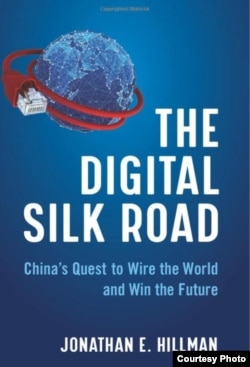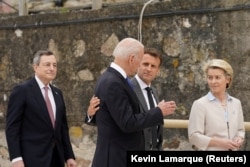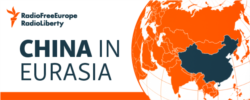
Although the pipelines, roads, and grand infrastructure projects of China’s controversial Belt and Road Initiative (BRI) have garnered the most attention as part of Beijing’s efforts to expand its economic and political influence around the world, a new book focuses on the growing digital side of that venture that could shape the economies of the future.
From a planned Chinese subsea cable connecting Pakistan and Djibouti to Safe City surveillance initiatives in Serbia and facial-recognition software used to crackdown on Uyghurs and other Muslims in western China now being used in Central Asia, author Jonathan Hillman gives a tour of this new battleground, charting its origins and showing where the competition is heading.
“We have only seen the first phase of the U.S.-China technology competition and it has been mostly focused in developed countries,” Hillman, author of The Digital Silk Road: China’s Quest To Wire The World And Win The Future, told RFE/RL. “But the real competition is set to play out across the developing world."
Hillman, an analyst and director of the Reconnecting Asia Project at the Washington-based Center for Strategic and International Studies, said: "It’s invisible, but everywhere. Even the traditional infrastructure projects all have a digital component to them."
From 5G to AI-enabled surveillance systems and fiber-optic cables, Beijing and Washington are fighting for control over the networks of the future and, as Hillman writes in his book, "the Network Wars have begun."
"This is a complex moment and the competition under way is even more complex,” he added.
'Invisible, But Everywhere'
In August, a multiyear legal fight between Chinese communication giant Huawei and a small U.S.-based contractor moved to an American federal court when the contractor alleged that Huawei had stolen its technology and pressured it to create a “back door” to gain access to a law enforcement project in Pakistan.
U.S. officials have long raised concerns about Huawei and how its equipment could be used by Chinese authorities to spy on the countries that install it, an allegation Huawei has repeatedly denied.
But Business Efficiency Solutions, the contractor, said in its lawsuit that Huawei forced it to set up a system that would give the Chinese company access to sensitive information about Pakistanis and government officials through the Chinese-backed Safe City surveillance project being installed in Lahore, Pakistan’s second-largest city.
The dispute is still tied up in court, but the episode -- though small in scale -- gets to the heart of the globe-spanning web of companies, contractors, new technologies, and national interests that forms the backbone of an intensifying rivalry between China and the United States.
Unraveling this complicated labyrinth of geopolitical ambition and next-generation technology is the focus of the book, which was released on October 19.
'The Network Wars'
As China’s Digital Silk Road expands across the globe, from Latin America to South Asia, the stakes remain high.
Beijing's quest for digital dominance comes from the top. Chinese President Xi Jinping has called for his country to lead advanced manufacturing by 2025, lead standard-setting for new technologies by 2035, and to become a superpower by 2050.
In order to achieve these goals, Xi has pushed Chinese companies to invest heavily in digital infrastructure inside China and spread more of their products abroad under the umbrella of the expanding BRI.
In this vein, it is the fight for the markets of tomorrow.
China’s success would bring commercial and strategic benefits to the country and allow Beijing to hold the reins on global finance, communications, and the flow of data, which could all be reshaped to better fit its geopolitical interests. All of these advantages are currently enjoyed by the United States.
A central part of Hillman’s book looks at how Washington helped enable China’s rise as a technology powerhouse, believing that technology could play a role in keeping the flow of information open and fueling a Chinese transition towards democracy.
“There was this overoptimism with technology and assuming that spreading connectivity and tech would help spread freedom,” Hillman said. “But technology is a tool and, as we’ve seen, it can also be used to repress and help authoritarians.”
According to a 2019 report by the Center for Strategic and International Studies, 71 percent of Huawei’s Safe City agreements are with countries that have a dubious track record on human rights.
A Shifting Battlefield
Chinese companies have expanded rapidly in recent years, winning greater market share by offering their products and services at lower prices and being able to operate with less oversight than their Western competitors.
In Central Asia, Chinese tech companies play a prominent role.
In 2019, Huawei closed a $1 billion deal with Uzbekistan to build a large-scale traffic-monitoring system and Hikvision, which has developed facial-recognition software that can target ethnic Uyghurs, is a major supplier for cities across Kazakhstan.
A police command center that opened in 2019 in Bishkek, the capital of Kyrgyzstan, has also turned to Chinese firms for facial-recognition cameras.
Russia has also cautiously leaned on Huawei for its next generation 5G telecommunications networks, which the Kremlin acknowledges the country is unable to produce at a high quality on its own. The move not only strengthens the Chinese company’s place in the Russian market, but also improves its position in the battle for other emerging markets.
As Hillman notes in his book, this tech competition is still in its early stages and could shift dramatically in the coming years as political events unfold and new technologies are developed.
Huawei, once seen as a juggernaut in Western policy circles, has been hobbled by a U.S.-led diplomatic and sanctions campaign, forcing the Chinese company to experiment with new business lines, cede overseas territory, and rebuild a supply chain independent of the United States.
In August, Huawei announced that its revenue had dropped by 29 percent in the first half of 2021, with its chairman saying the company’s “aim is to survive.”
The United States, the European Union, India, and Japan have also moved to form alternatives to BRI and taken a strong focus on digital infrastructure, although those initiatives are still in their nascent stages.
For Hillman, this gets to one of the most difficult challenges for the United States as it looks to compete with China on the digital battlefield across the world.
So far, the majority of U.S. measures have been what Hillman calls “defensive,” such as sanctions and export controls. Moving forward, the United States will also need to press on with its own “offensive” moves, such as developing new technologies and broadening access to information.
“There is a risk of only criticizing China’s activities without offering credible alternatives,” he said. “We need to think of how to compete and not just criticize.”











